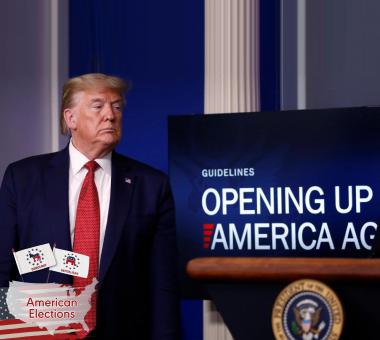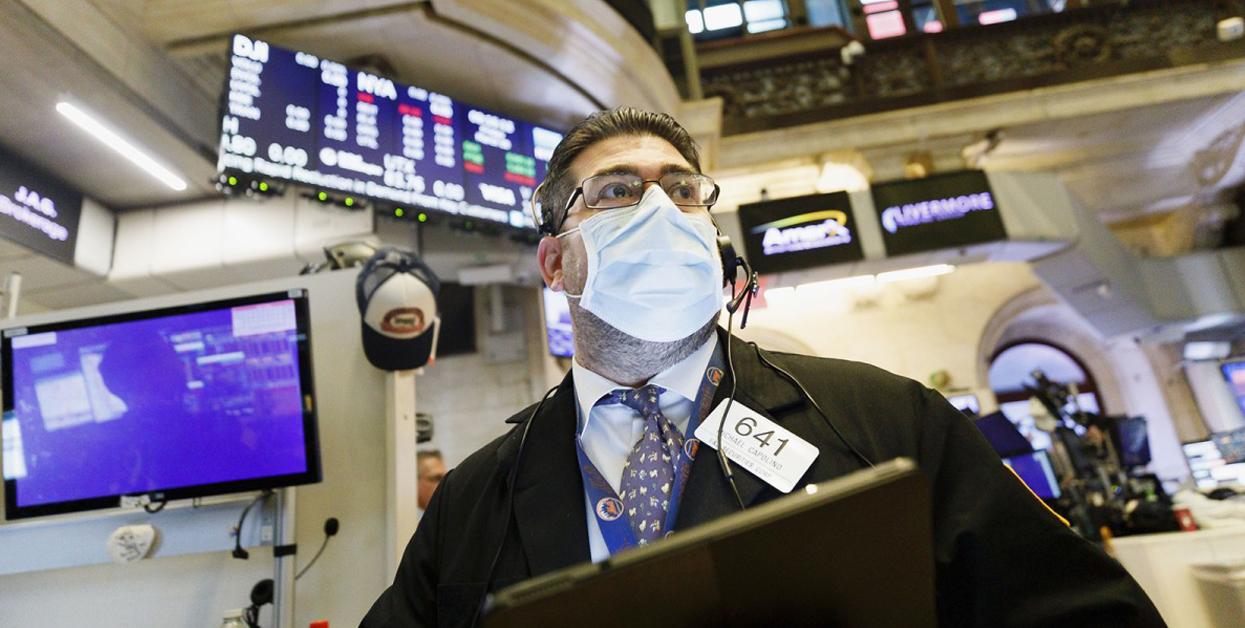The US Economy Situation under pressure of political competition and health crisis
The US economy is witnessing high levels of instability over the coronavirus pandemic, thus affecting Trump’s chances of winning the race for Us presidency. This articles summarizes the path of the economy under Trump, shedding the light on the most prominent criticisms made about it prior to and post the novel coronavirus outbreak.
by STRATEGIECS Team
- Publisher – STRATEGIECS
- Release Date – Oct 26, 2020

*This is the third article in a set of articles and papers published successively, discussing certain aspects of the internal and foreign dimensions of the upcoming US elections.
The US President, Donald Trump, has always stated in press conferences and other political events that his administration has worked to rebuild the economy by improving economic growth and greatly enhancing its indicators as well as strengthening the US economic position in the international arena. Yet, the measures that have been taken to deal with the economy are still a subject of controversy not only among the candidates for the US presidency, but also among the leaders of the international community, including states, organizations and concerned bodies.
Those who are considering Trump administration’s handling of the economic file during the last four years must review the state of the US economy before the coronavirus outbreak - which threw new economic and health challenges - and then compare it with the current situation undergoing a state of uncertainty about the end of the pandemic and the consequent possible breakthrough in the economy.
Cautious stability
In January 2020, Businessinsider website reported a comparison of the state of the US economy during the era of Trump, Obama, and Bush Jr. The report indicates that Trump did not, in the first place, inherit the economy in a bad condition when he entered the White House in 2017, and this is due, in part, to the stimulus plan implemented by Obama administration in the wake of the global financial crisis that led to a 2.5% deflation. Thus, the positive economic indicators that Trump achieved in the first three years can be viewed as a continuation of the economic stability inherited after the administration of Barack Obama.
The unemployment rate reached its peak during the financial crisis, with 8.7 million jobs lost between 2007-2010, reaching 10.2% in October 2009 (at the end of the Bush Jr. era), before it decreased somehow dangerously after 2011. According to the website, job growth under Trump was similar to that of Obama's era, as the unemployment rate reached 3.5% in October 2019 – compared to what the US economy has been witnessing for half a century; however, wages under Trump grew by 3%, possibly due to the tax reductions recommended by Trump administration for American institutions and companies.
As for stock markets, the statistics of the aforementioned website indicate that the S&P 500 index, which measures the stock performance of 500 large companies listed on stock exchanges in the United States, has witnessed a fluctuation in Trump era compared to its performance under Obama and even during the Bush era, with the exception of the 2008 - 2009 financial crisis. The reason for this is the hazy scene created by the US administration's trade policy. This scene can be generalized to the overall performance of financial markets during Trump's presidency.
The Council of Economic Advisers CEA report, published on the White House website in February 20, 2020, pointed out that despite the "strong headwinds" that negatively affected global economies, the Administration’s flexible management of the economy has led to the growth of many indicators that include consumer spending, productivity, and labor share of national income.
The report shows that the growth in energy production (oil and shale gas) saved the average American family an estimated $ 2,500 annually. This would not have happened had it not been for the cancellation of the clean energy plan. In another point directed against Obama administration, which approved the health care law known as Obamacare, the report states that "choice and competition" are the principles governing the strengthening of the American health system, given that competitiveness drives the growth of the economy in general.
At the end, the report expected that the US economy would grow at a rate of 3.1% in the four quarters of 2020, and an annual rate of up to 2.9% in the period between 2019 and 2030 in the event of the continuation of the same current political and economic agenda.
It is clearly evident that there is an escalating debate about the effectiveness of Trump administration's handling of economic files and the associated implications the Americans experience on a daily basis. However, there are some indications that are inconsistent with Trump's statements and approaches to enhance the role of American industry. For example, the Industrial Supply Index fell to a level described as dangerously low in August 2019, which was threatening a recession, according to Tim Fiore, chair of the Institute for Supply Management Manufacturing Business Survey Committee, who also indicated that the manufacturing sector witnessed a deflation for the first time since 2016, as the percentage of orders in hand increased by 0.1% compared to July 2019.
In the same period, the number of industrial workers decreased in the states of Wisconsin, Michigan, North Carolina, and Pennsylvania, driving Louisiana Governor, John Bill Edwards, of the Democratic Party, to attribute the reason for the decline in industrial demand to the trade wars led by Trump administration which defends the resilience of the US economy in the face of the media accused by the White House trade advisor, Peter Navarro, of dealing with economic numbers and indicators selectively.
These indicators may have prompted, in one way or another, the US administration to sign what is known as Phase One of the trade deal with China on January 15, 2020, nearly 18 months after the outbreak of the trade war between them. It is reported that it has greatly affected American farmers for whom China represents an important destination with regard to their products, especially soybeans. The imposition of customs duties on these products forced the US administration to allocate large support packages, although this only solved part of the problem.
The blame cannot be completely placed on Trump’s economic administration prior to the Covid-19 crisis. This is due to many factors, most notably the relative independence of the Federal Reserve Bank in taking decisions governing the US fiscal policy which Trump considered - before the pandemic - a barrier to fully achieving his economic program. But yet, his opponents inside and outside the Federal Reserve Bank argue that the cause of the economic problems is the trade policy.
What happened after Covid-19 outbreak?
The US economy under Trump has truly achieved remarkable stability, as the first three years witnessed an annual growth rate of 2.5%. However, the second quarter of 2020 witnessed a deflation of 30% that may be the largest since registrations began. Unemployment has peaked since the Great Depression in the 1930s, reaching14.7% in April 2020.
The outbreak of the novel coronavirus brought about a state of economic instability worldwide and drove it into a crisis that extended to infect all economic activities. This crisis had a great impact on the American society, shown by the indicators that suffered free-fall in the negative zone as can be seen above, with the increasing rates of unemployment, poverty, etc..
Among the economic sectors that have been severely affected by the outbreak are small and medium-sized companies which work in the field of retail trade, construction, health care, and others. These are not often referred to in favor of focusing on large and transcontinental companies, although they include approximately 47% of the American workforce, in addition to their contribution to creating liquidity and thus monetary stability.
The announcement by US President Donald Trump of a national emergency to contain the outbreak of the novel coronavirus, in March 2020, represented a pivotal point in economic life and Trump's political career in the White House. For his economic achievements were blown up, regardless of the controversy surrounding it, and it became necessary for him to deal with the economic effects of the pandemic not the means to find mechanisms to achieve his own economic visions.
Accordingly, the White House approved the largest financial aid package in the country's history by $ 22 trillion in late March (2020), followed by a number of other legislations including hundreds of millions of dollars in aid to individuals, institutions and health sector.
Comparing between the economic events in the reigns of Bush Jr. and Trump, there is an expansion in the state consumer spending driven by tax reductions. However, Bush era ended in a global financial crisis, whereas the outcome in Trump's case is still unknown, but it is definitely negative. Despite the partial improvement of some indicators in the second and third quarters, there are fears of continued negative growth, threatening a long-term recession that may accompany the US dollar depreciation.
The former president of Morgan Stanley Asia and professor of economics at Yale University, Stephen Roach, believes that the collapse of the US currency has become a possible scenario due to the exacerbation of structural imbalances between savings and the current account that have intensified with the outbreak of the novel coronavirus. This confirms the expectation of the Congressional Budget Office that the US public debt will account for 98% of GDP by the end of this year (2020), in addition to a deficit of 16% in the general budget.
Roach points out, in his article published by Bloomberg last June 2020, that national savings have decreased by 1.4% of national income, which is the lowest since 2011. This means that unemployment benefits and direct aid to families will have only a temporary effect. The situation will get worse if Beijing engages in buying US bonds, the matter which raises the question: Who will fund the dollar?
The insane rise in gold prices in the period between 2019-2020 and the fluctuation of data about the future of the US economy warn that confidence in the dollar as a safe haven has decreased, not to mention that many eastern countries abandon the “green currency” in the two-way trade operations that combine them, in addition to the fact that Washington has not provided any proposal for a virtual currency that could compete with the digital Yuan issued by the Chinese Central Bank in May 2020.

Presidential Elections vis-à-vis the Economy
It is known that the economic reality in any society draws the political orientations of the masses involved, by representation or election, in the political process. There is no doubt that American voters try to choose the candidate whose executive team can get the Americans out of their economic and social predicament.
The Democratic Party took advantage of the situation under the pandemic to count Trump administration responsible for all the health and economic ramifications that afflicted the country, pointing that if it had only taken early and preventive measures, the situation would not have reached such level of deterioration. The Republican camp responded by attributing the deterioration to the pandemic which is considered an exceptional circumstance that plagued the whole globe.
Trump still has an opportunity in many economic sectors to which he has allowed economic reductions, not to mention Silicon Valley that could push for Trump's election. This is due to the fear of many company owners there about the technology companies dismantling bill proposed by lawmakers who belong to the Left Democratic Party. Thus, Trump may be the least burdensome option for Silicon Valley despite the occasional skirmish between him and some social media platforms about the extent of the fairness of representing the Republican discourse through it.
What is unique about these elections is that no one knows - including the candidates - what will happen to their economic programs if the pandemic continues, bringing economic indicators to dangerous levels. But what the American political elite knows for sure is that the country is heading towards an unclear economic crisis that may extend for at least three years.
In conclusion, we can say that after Trump administration’s economic achievements collapsed due to the pandemic, the man lost many of his marketing tools. Yet, that does not constitute a decisive conclusion, because there are cultural and intellectual dimensions that link Trump administration to many sectors, organizations and lobbies which express certain economic and political interests, whether at the local or foreign level, and are interested and even favor the mechanism of Trump and his team in dealing with the concerning issues. Thus, a second term for Trump is still a chance among others that seem largely unclear.

STRATEGIECS Team
Policy Analysis Team
 العربية
العربية